Chicken Combs: A Complete Guide (+ Pictures)
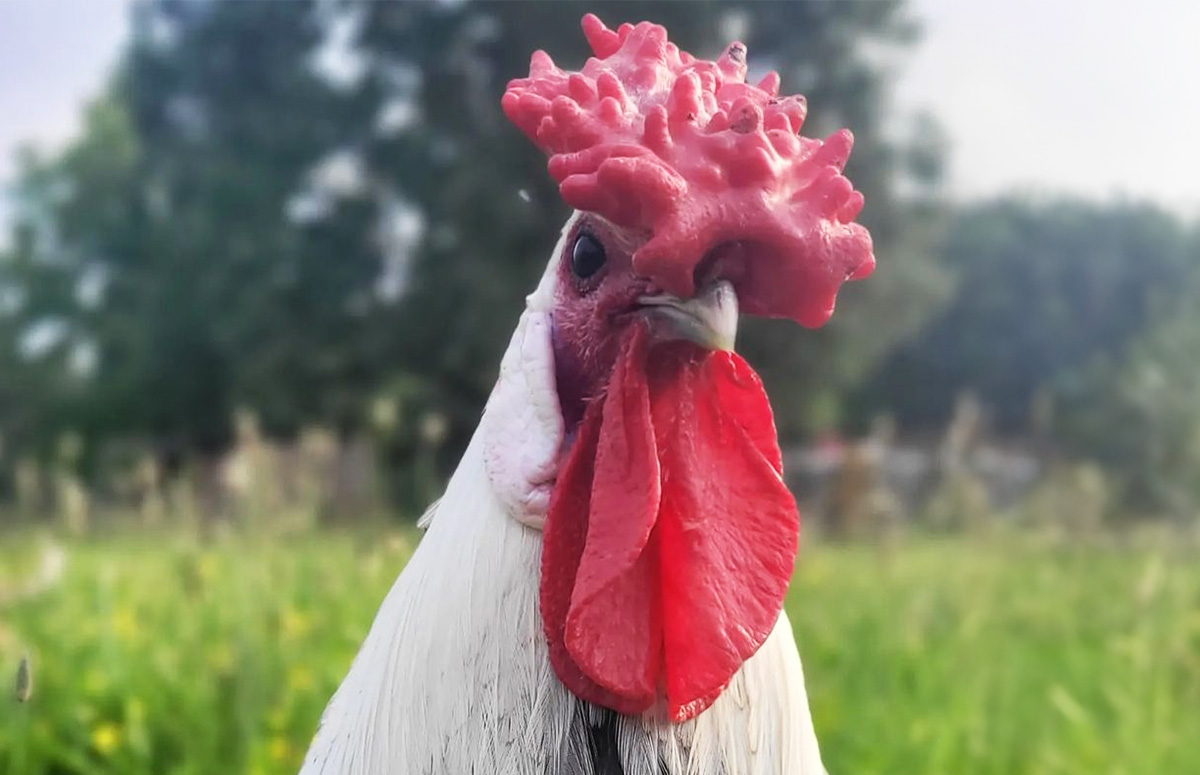
Feathers, beaks, and wattles are some of the features that immediately come to mind when we think of chickens. However, one aspect adds a touch of uniqueness to these them—their combs. Each breed has a specific comb type and while some are more common than others, all have a unique beauty to it.
Let’s address all different comb types with pictures and see what breeds carry which type of comb.
- Single Comb
- Buttercup Comb
- Pea Comb
- Strawberry Comb
- Rose Comb
- Walnut Comb
- V-shaped Comb
- Cushion Comb
- Shell Comb
1. Single Comb
The single comb is the most common comb type among chickens. It extends in a single line from the base of the beak to the back of the head.
This comb type consists of a solid vertical part with a series of points, the size and shape of which vary depending on the breed. Young birds have smaller combs compared to mature ones.
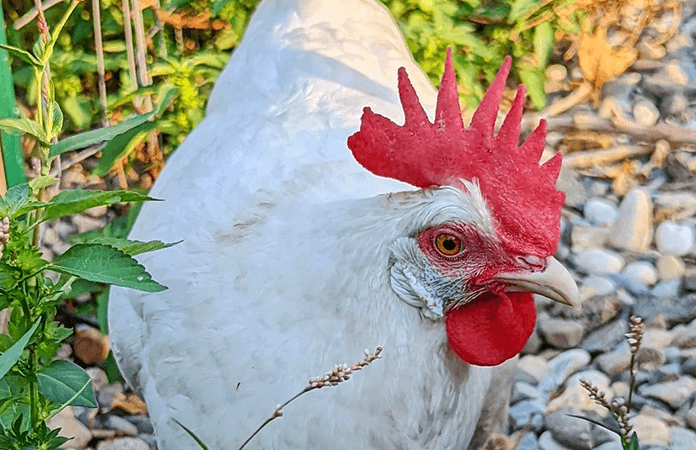
A prime example of a breed with a single comb is the Rhode Island Red; although this breed also has a rose comb counterpart, this type is very uncommon. Many other standard breeds carry a single comb such as Sussex, Australorp, Plymouth Rock and Leghorn.
The single comb is also very common with hybrid chickens, not real heritage breeds, but hatchery mixes, created for their egg-laying skills or specific looks. Examples of hybrid chickens carrying a single comb are Cinnamon Queen, ISA Brown, Golden Comet, and California White.
2. Buttercup Comb
This unique comb type is exclusive to the Sicilian Buttercup, a beautiful chicken with a flower pattern originating in Italy.
A buttercup comb is totally unique for this breed but is a recognized comb type by the American Poultry Association. According to the APA, the comb should look like “a cup-shaped crown well set on the center of the skull and surrounded by a complete circle of medium-size regular points”.
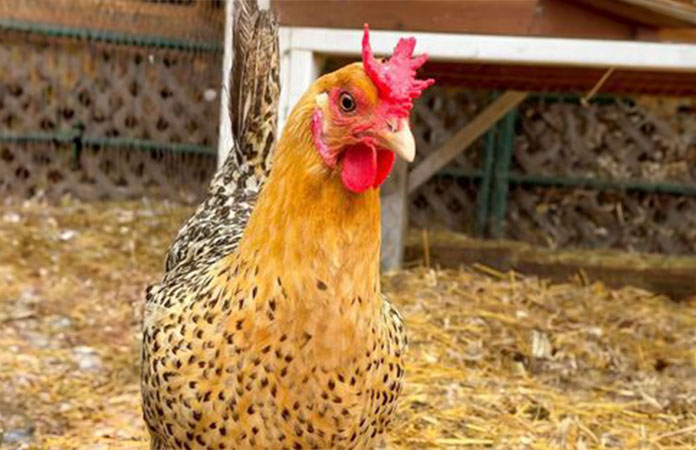
The Sicilian Buttercup is a beautiful and rare chicken breed from Sicily, Italy. Known for its distinct buttercup comb type, the breed also features golden buff plumage with black spangles, and willow green shanks and toes.
While their egg production is moderate, they are valued for their active nature, making them excellent foragers.
3. Pea Comb
The pea comb is a comb-type found in certain chicken breeds. It is named after its resemblance to three small single combs in a row, resembling a row of peas. This comb type is characterized by its compact and low-profile structure.
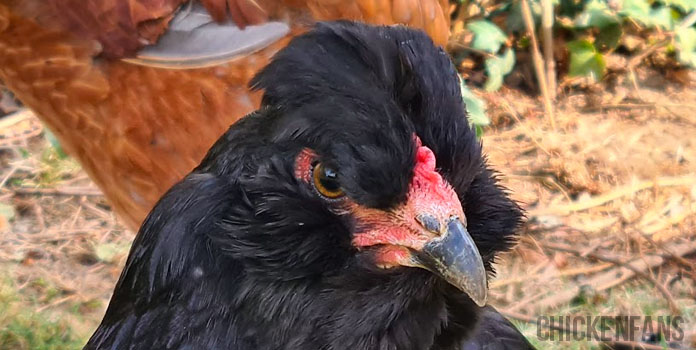
The pea comb comprises three distinct sections. These sections are usually evenly spaced and connected, forming a neat and uniform comb.
One advantage of the pea comb is its suitability for colder climates. The smaller surface area of the comb reduces the risk of frostbite. Chickens with pea combs are, therefore, more likely to be cold-hardy and are more suitable to keep in colder regions.
Several chicken breeds exhibit the pea comb, including the Araucana, Brahma, Buckeye, Indian Game, and Sumatra. Each breed may have its own unique variation of the pea comb.
The blue egg gene is connected with the pea-comb gene, so blue-egg layers, like an Araucana and Prairie Bluebell Egger, will carry a pea comb. This includes the hybrid Easter Egger, although they sometimes have a single comb as they are a mixed breed.
4. Strawberry Comb
The strawberry comb is a low-lying comb that sits forward of the skull and protrudes over the top of the beak.
Its name is derived from its shape and texture, resembling a strawberry, with the wider end covering the beak. The strawberry comb is not as common as other comb types, but it can be found in certain breeds exhibiting this particular variation, like the Malay or Yokohama.
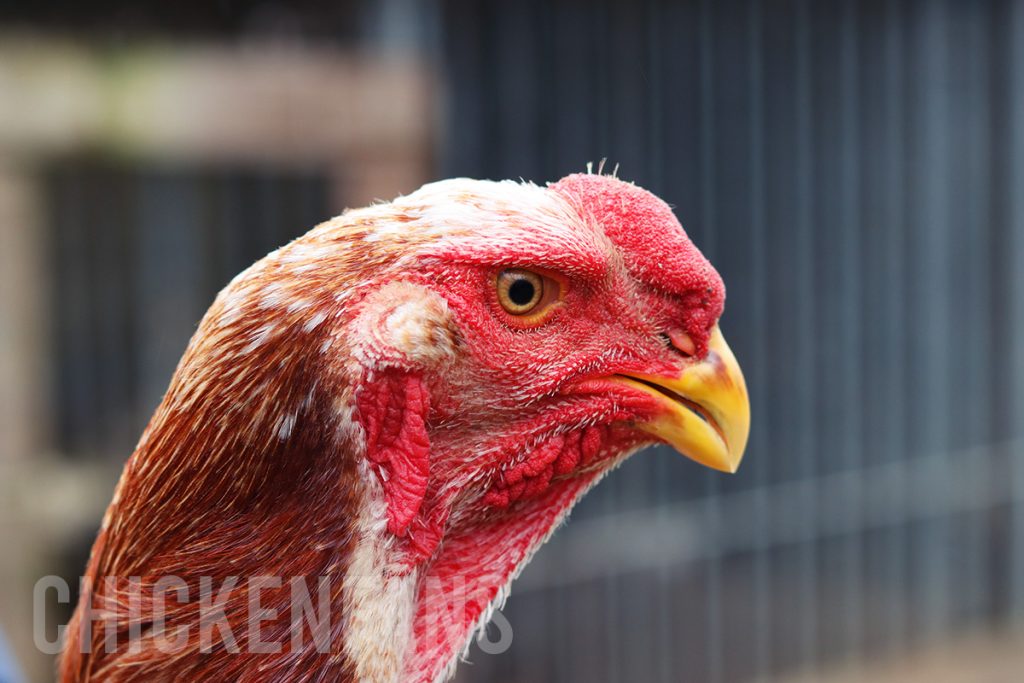
The Asian Malays thrive well in hot climates and warm temperatures as long as they have plenty of water and shade. Modern lines can also withstand the cold reasonably well these days. Their little wattles and small strawberry comb are not prone to frostbite either. That said, they are no oriental penguins, either.
5. Rose Comb
The rose comb is very similar to the strawberry comb, except it forms a point and is more smooth and flat than the strawberry comb. It is a common and well-known type of chicken comb.
Unlike many other comb types, the rose comb lacks prominent spikes or serrations. Instead, it has a uniform curvature, resembling a flat, symmetrical crown on the chicken’s head. The name ‘rose’ comb comes from the resemblance to rose petals. Although a rose comb may look ordinary or flat, there are many examples of chickens (mostly roosters) carrying a strikingly beautiful rose comb.
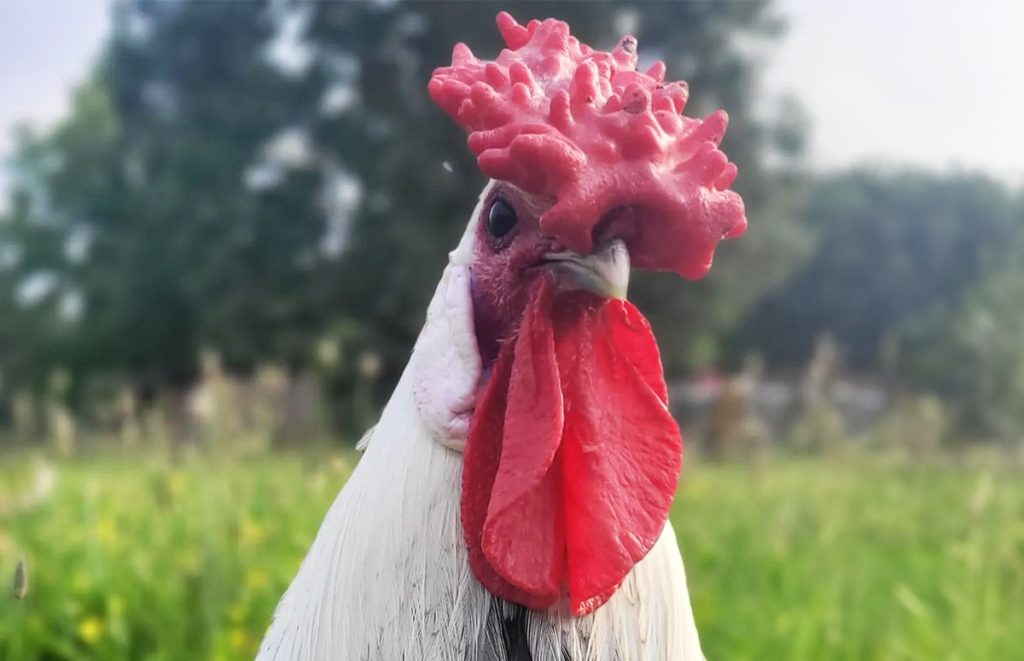
The rose comb is found in several chicken breeds, including the Hamburg, Wyandotte, and Rosecomb Bantam.
One advantage of the rose comb is its suitability for hot and cold climates. Its broad and smooth surface helps dissipate heat during warm weather. Additionally, the compactness of the rose comb reduces the risk of frostbite in colder temperatures.
6. Walnut Comb
The walnut comb is characterized by its compact and rounded structure, sitting low on the chicken’s head.
This comb type is typically small and relatively flat. It lacks prominent spikes and has a smooth surface. The comb’s rounded shape and contours resemble half a walnut, with the wider end covering the beak area.
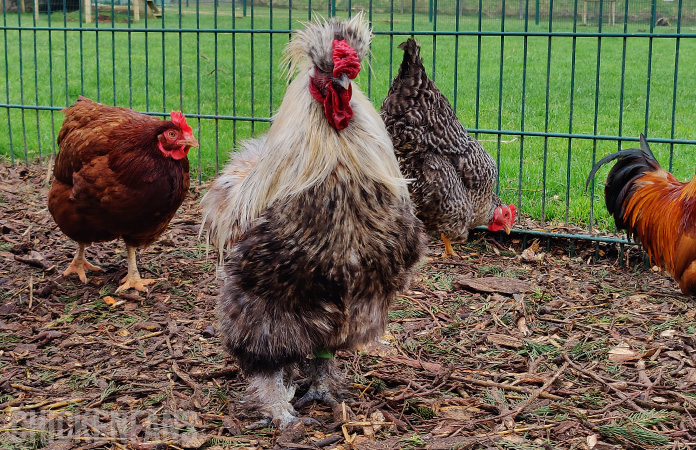
The walnut comb is not that common in chickens, although it can be found in one of the most popular chicken breeds in the world, Silkies. Both Silkie hens and Silkie roosters carry this unique comb type. Other less common breeds carrying this comb type are the Thai Game Fowl and Orloff.
Like most compact combs, the walnut comb is well-suited for cold climates. Its small surface area reduces the risk of frostbite, protecting the delicate comb tissue from extremely cold temperatures.
7. V-Shaped Comb
The V-shaped comb, or the horn comb or V-comb, is characterized by two spikes that form a V shape starting above the beak and tapering to a point from a thicker base.
The V-shaped comb is typically larger and more prominent than other comb types. It adds a bold and eye-catching feature to the chicken’s head, giving it a unique appearance. This comb type is found in breeds such as the Polish, Crèvecœur, Pavlovskaya, La Flèche, Appenzeller Spitshauben, and Sultan.
As Pavlovskaya and Polish chickens have a large crest, it often hides their comb.
8. Cushion Comb
A cushion comb is a smooth comb without any spikes. It looks similar to the rose comb but has no pointy end and is more compact. This comb type is seen in the Cantecler chicken.
Chickens carrying a cushion comb are very cold-tolerant. There is a very low risk of these chickens suffering from frostbite.
9. Shell Comb
The shell comb, also known as the leaf comb, is a comb-type named after its resemblance to a butterfly with partially-opened wings or the shape of a shell.
It has a central ridge that runs from the base to the back of the head, with smaller serrations branching off on each side.
The shell comb is not as common as other comb types, and its prevalence is limited to specific breeds or variations. The Houdan chicken is an example of a chicken breed carrying a shell comb.
Why Do Chickens Have a Comb?
The primary purpose of a chicken comb is to help regulate the chicken’s body temperature. Chickens don’t sweat like humans; they rely on other mechanisms to cool themselves down. During hot weather, chickens use their comb to dissipate heat by circulating blood throughout their comb and wattles.
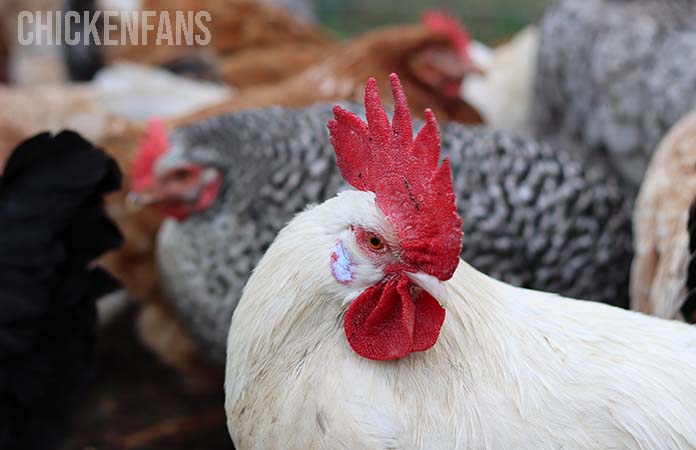
Chickens take temperature changes reasonably well but stand cold temperatures better than hot ones. A chicken’s body fat, found under the skin, and its warm feathery coat protect them from low temperatures, but it makes them not fond of hot temperatures.
On the other hand, some breeds are more cold-tolerant than others because of the type and size of their comb. Chickens with smaller and compact combs are more cold-tolerant and their combs are less prone to frostbite.
Additionally, the condition of a chicken’s comb reveals much information about its health. A pale comb can indicate parasites, general problems with their well-being, or poor health. Black spots on a comb can mean many things, like peck marks, fowlpox, or fleas. A purple comb is seen in fowl cholera, while white spots may indicate a fungal infection.
By monitoring the condition of your chickens’ comb, you can gather valuable information about their health. Sudden color changes indicate something is going on with your chicken’s well-being, and keep a lookout for dry and flaky combs.
Are Chicken Combs Always Red?
No, although chicken combs are mostly red, several breeds carry a black chicken comb, like the Ayam Cemani, or the Fibro Easter Egger. They are part of a special group of black chickens with Fibromelanosis, which causes hyper melanin or hyperpigmentation. As a result, these chickens are completely black, including comb.
Summary
From the single comb to the strawberry comb, we’ve discovered the diverse shapes and functions of chicken combs. These combs help with thermoregulation, and health indications, so regular checks are crucial for your flock’s well-being.
Credits Featured Image: @brandy_l_m_ (IG)


















